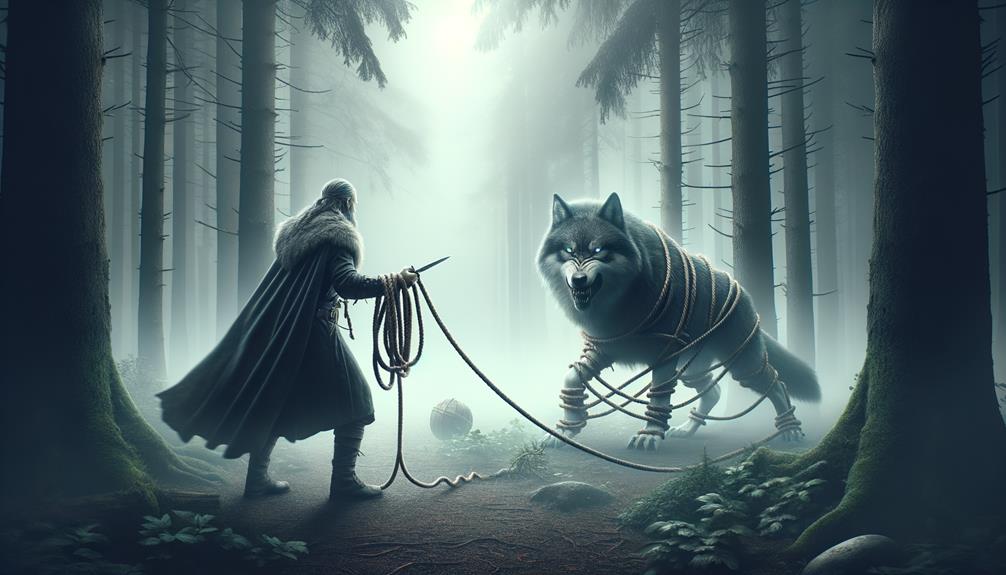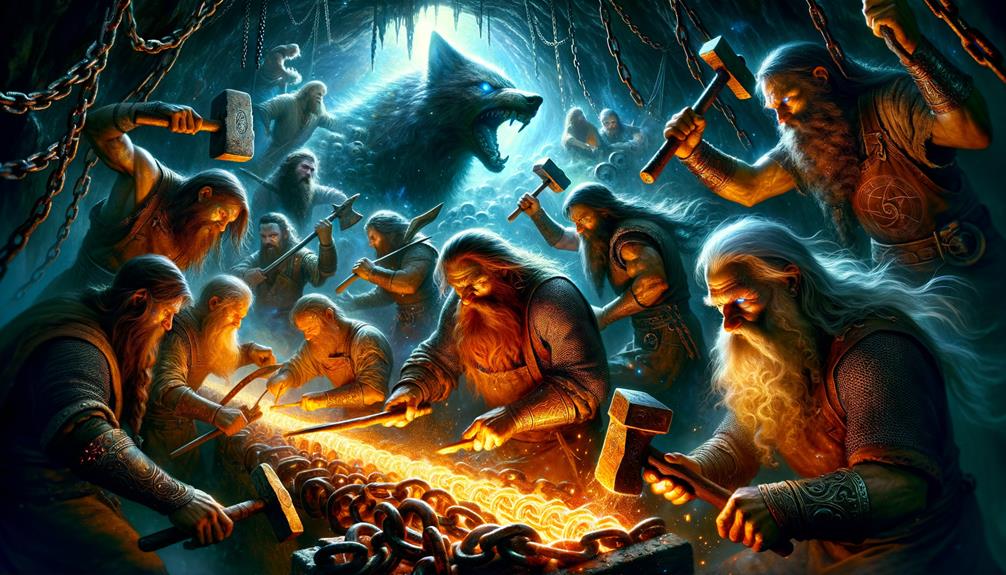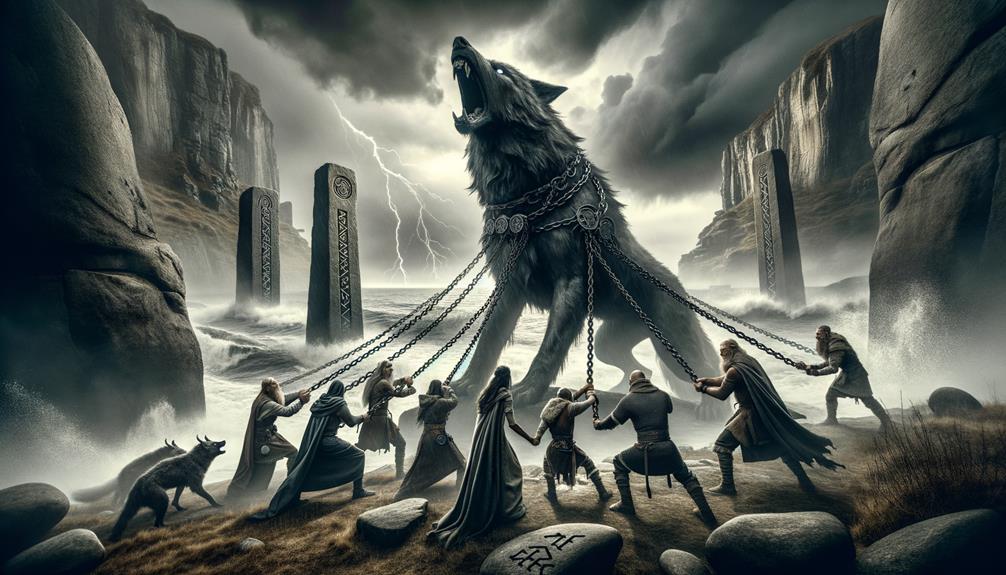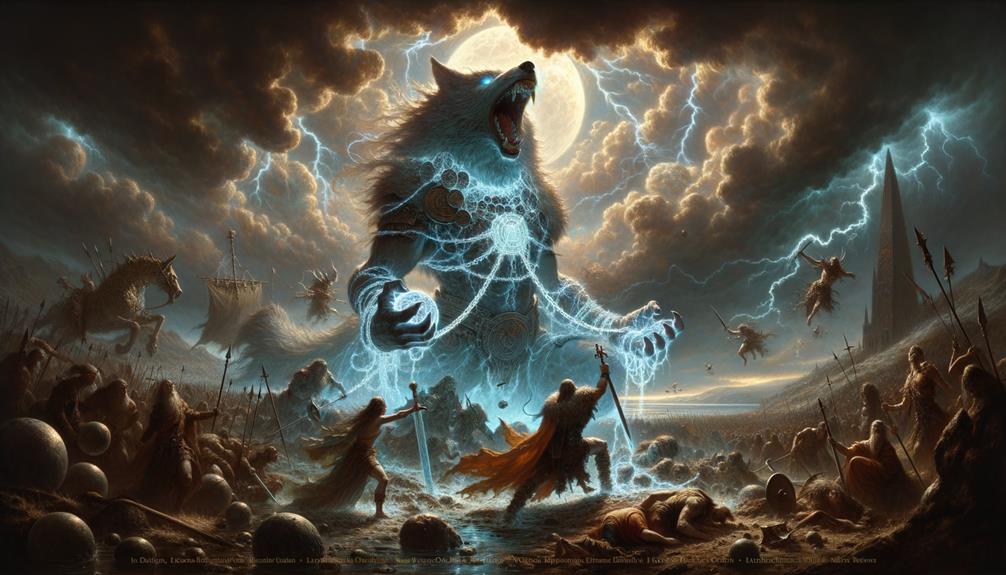Fenrir, a terrifying wolf from Norse mythology, is foretold to bring about chaos during Ragnarok – the end of the world. The gods, in their wisdom, decide to take action to prevent this disaster. They enlist the help of the dwarves, skilled craftsmen, to create Gleipnir, a one-of-a-kind binding made from six unlikely components.
To successfully restrain Fenrir, the gods use wit and personal sacrifice. Tyr, a brave god, even offers his hand to Fenrir's jaws. Once Fenrir is bound with Gleipnir, along with a few extra chains for good measure, the threat he poses is effectively neutralized.
This saga is an intricate weave of strategic planning, self-sacrifice, and symbolic undertones. If you take the time to delve deeper into this narrative, there's a whole lot more to unpack.
Fenrir's Origins and Prophecy
Let's chat a bit about Fenrir. If you're into Norse mythology, you've probably heard of this fearsome wolf. The child of Loki and the giantess Angrboda, Fenrir was a symbol of great power and fear. You see, his parents were no ordinary beings – Loki was the god of mischief and Angrboda, a fearsome giantess. So, you can imagine the kind of chaos a creature like Fenrir could bring.
The Prose Edda, a source of much of our knowledge of Norse mythology, forecasts a grim future involving Fenrir. He's destined to have a central part in Ragnarok, a catastrophic event that's basically the end of the world. And it doesn't stop there – Fenrir's linked to Jormungandr, the World Serpent, echoing his crucial role in these disastrous happenings.
Concerned about Fenrir's destructive potential, the gods tried to put him in chains. Their goal? Keep his uncontrolled power in check and forestall a total disaster in their world. The fact that the gods went to such lengths to restrain Fenrir tells you just how serious a threat he posed. They were desperate to keep things under control.
The Deceptive Plan of the Gods

Looking at how the gods creatively plotted to bind the terrifying Fenrir, it's truly captivating. Knowing a prophecy that predicted Fenrir would unleash chaos among them, the gods requested the dwarves to make a binding. They didn't rely on brute strength to restrain the wolf Fenrir, but instead, they cleverly used a more subtle approach. They presented this binding, known as Gleipnir, as a challenge to Fenrir's strength, adding another layer of trickery to their plan.
| The Gods' Crafty Scheme | Outcome |
|---|---|
| Asked the Dwarves for Help | Gleipnir Produced |
| Tried to Bind Fenrir | Fenrir Underestimated Them |
| Gods Showed Gleipnir to Fenrir | Fenrir Got Trapped |
Their approach may have been sly, but it was undeniably effective in holding back the mighty power of Fenrir.
Keep in mind that sometimes, straightforward language can send the message across more clearly. If a sentence seems too complicated, consider simplifying it or replacing fancy words with more direct ones. Make sure your language reflects current happenings and commonly used terms. Steer clear from worn-out phrases and words. Instead, use original expressions or direct descriptions.
Transition words are great, but they shouldn't be overused. Aim for a natural flow in your writing with contextual transitions based on the content. Exaggerated language can be tempting to use to make a point, but it can take away from the credibility of the article. Stick to the facts and back up claims with evidence whenever possible.
Remember your audience. Adjust your language to fit their knowledge base and familiarity with the subject matter. An active voice makes your writing clearer and more direct, so opt for this over passive voice whenever you can. Instead of just stating that something is 'important' or 'essential,' explain why it's significant. This gives the reader better understanding and makes the content more engaging.
Dwarven Craftsmanship: Gleipnir

Isn't it fascinating how the gods came up with such a crafty plan? Let's chat about the heart of their strategy: Gleipnir. This isn't just any old dwarven handiwork. It's an artifact that may have looked like a chain, but was far from ordinary. This thing was made of six bizarre elements: the sound a cat makes when it steps, a woman's beard (yes, you read that right), the roots of a mountain, the strength of a bear, the breath of a fish, and bird spit. It's hard to wrap your head around, right? But these mystical and powerful parts made Gleipnir a force to be reckoned with, so much so that not even Fenrir could break it.
And let's not forget Tyr's gruesome sacrifice. He offered his hand to Fenrir's jaws – a chilling reminder of the lengths the gods were willing to go to restrain Fenrir. It's an intense story, isn't it? The cunning and sacrifice behind Gleipnir, according to Old Norse mythology, perfectly illustrates the gods' desperate measures to control Fenrir's terrifying power.
The Struggle and Final Binding

So, you're curious about how the gods finally managed to tie up Fenrir, that terrifying wolf, with something as delicate as Gleipnir? Well, let me tell you, it wasn't a walk in the park. The gods had to pull out all the stops, convincing Fenrir that the chain was simply a test of his strength.
Fenrir, being no fool, demanded some assurance. Brave Tyr came forward, placing his hand in Fenrir's mouth as a sign of trust. They then wrapped Gleipnir, as light as a cat's gentle step but as tough as mountain roots and a woman's beard, around Fenrir.
When Fenrir realized he was stuck, he did what anyone would do – he lashed out and bit off Tyr's hand. Fenrir's cries of pain and frustration formed a river known as Ván, and to make sure he stayed put, they added extra bindings, Gelgja and Thviti. This kept him out of trouble until Ragnarok.
Symbolism and Interpretations of the Tale

When we start to dig into Fenrir's binding tale, we uncover a treasure chest of symbolism and meaning. The wolf, destined to destroy a god, is a symbol of an unstoppable, chaotic force. To combat this, the gods whip up Gleipnir, a chain that's as light and flexible as it is unbreakable. It's as if they're trying to hold back a wild storm with nothing more than a spider's web. This clever tool represents their strategic approach to control the uncontrollable. Tyr's sacrifice, where he loses his hand to Fenrir, is a powerful reminder of selflessness, courage, and fate acceptance. When we read this tale from the lens of interpretation, we gain a deeper understanding of the rich tapestry of Norse mythology, with its emphasis on destiny, loyalty, and action consequences.
Frequently Asked Questions
What Is the Rope That Binds Fenrir?
You know the rope that holds Fenrir in check? It's called Gleipnir, a mystical chain created by dwarves. Despite looking as slight as a silk thread, it packs a punch when it comes to strength! In the context of Norse lore, this restraint underscores Fenrir's power and his importance in mythology.
What Was Used the Third Time to Bind Fenrir Wolf?
The third time they tried to tie up Fenrir, the wolf of Norse mythology, they used something called Gleipnir. It was a pretty sneaky move by the dwarves who made it. You see, Gleipnir looked simple and harmless, but it packed a punch. It was a clever bit of trickery that played right into a prophecy about Fenrir. To say it was a big deal would be an understatement.
What Is the Myth of Fenris the Wolf?
Let's have a friendly chat about Fenris the wolf, a fascinating character from Norse mythology. This wolf isn't just any wolf; he's the child of Loki, the notorious trickster god. Fenris has a lot of weight on his shoulders in the myths, playing a pivotal role in the end-times prophecy, Ragnarok.
His origin story and his offspring are far from ordinary, they're chock-full of mythical importance. But what really makes Fenris a standout character is his symbolic role. He represents the ongoing tug-of-war between destiny and the freedom to choose one's path. The stories around Fenris raise thought-provoking questions about our own lives and the balance between what is predetermined and what we can control.
Is Fenrir Actually a Wolf in AC Valhalla?
Absolutely! Fenrir in AC Valhalla is indeed portrayed as a real wolf. This depiction aligns with the symbolic representation of wolves in Norse mythology. The game does a fantastic job of keeping true to Fenrir's original role, creating an intriguing portrayal of this intimidating beast.


